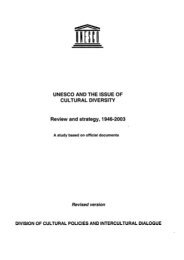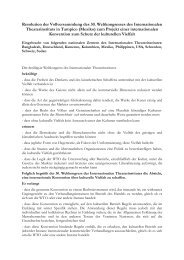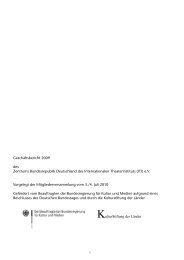Kultur in Gefahr - ITI
Kultur in Gefahr - ITI
Kultur in Gefahr - ITI
Create successful ePaper yourself
Turn your PDF publications into a flip-book with our unique Google optimized e-Paper software.
58 Artistic Expression <strong>in</strong> a Corporate World<br />
Artistic Expression <strong>in</strong> a Corporate World 59<br />
buy diversely. If this is true, then the question of ownership concentration<br />
of record shops becomes relatively less important.<br />
This would replace the need for regulation to another category of<br />
regulations, namely the field of content regulations (see below). Then,<br />
public and private channels could be obliged to broadcast, for <strong>in</strong>stance,<br />
thousands of different songs a year, even at prime time, that come from<br />
many different and <strong>in</strong>dependent sources, and many different countries.<br />
It is <strong>in</strong>terest<strong>in</strong>g that the distribution of music gets another<br />
perspective partly by the rapid development of the peer-to-peer systems<br />
of music exchange. If the cont<strong>in</strong>u<strong>in</strong>g trend is that the music <strong>in</strong>dustry,<br />
followed by the film <strong>in</strong>dustry, is sell<strong>in</strong>g less, then this might become an<br />
attack on their dom<strong>in</strong>ant positions. But what positions are at stake? In the<br />
field of distribution, certa<strong>in</strong>ly, and also their copyrights loose market<br />
value. But what about the production of music and films? Until now, it<br />
seems that most people exchange music and films that have been<br />
produced by the cultural giants and made popular by their market<strong>in</strong>g<br />
mach<strong>in</strong>es.<br />
A real attack on the dom<strong>in</strong>ant position of the music and film<br />
<strong>in</strong>dustry would be for more and more artists to produce and distribute<br />
themselves us<strong>in</strong>g the rapidly develop<strong>in</strong>g tools of digitalisation and the<br />
<strong>in</strong>ternet and not to contract themselves to the cultural <strong>in</strong>dustries.<br />
However, this option is more available for artists <strong>in</strong> the richer countries<br />
and selected groups <strong>in</strong> poorer parts of the world. Besides, audiences could<br />
do two th<strong>in</strong>gs. First, they develop curiosity to this diversity, and change<br />
and adapt the works creatively, no longer be<strong>in</strong>g passive exchangers of<br />
what is on the hit lists. And second, of course they should, and will, pay<br />
the small amount of money directly to the artists for the use of their works.<br />
(e) Is there someth<strong>in</strong>g wrong with foreigners own<strong>in</strong>g important cultural<br />
production and distribution facilities <strong>in</strong> a specific country? Yes, <strong>in</strong>deed. It<br />
<strong>in</strong>creases the chance for artistic expression to no longer be related to the<br />
specific circumstances of people liv<strong>in</strong>g <strong>in</strong> that country. The Universal<br />
Declaration of Human Rights demands that people should have the right<br />
to participate <strong>in</strong> the cultural life of their community. In Canada, for<br />
<strong>in</strong>stance, it is proven that domestic producers offer substantially more<br />
domestic content than foreign producers. In the field of books, perhaps<br />
twenty per cent of sales are generated by Canadian publishers, but they<br />
are responsible for 85 to 90 per cent of the Canadian titles published. It is<br />
the same <strong>in</strong> the music <strong>in</strong>dustry. Canadian producers br<strong>in</strong>g the<br />
overwhelm<strong>in</strong>g bulk of Canadian artists who are recorded onto the market.<br />
This does not mean that it is sufficient to have foreign ownership<br />
limits. This, <strong>in</strong> itself, does not guarantee a rich offer of diverse k<strong>in</strong>ds of<br />
artistic expressions. Foreign ownership restrictions should be comb<strong>in</strong>ed<br />
with other regulatory measures, particularly various content quotas.<br />
Nevertheless, restrictions on foreign ownership give a better chance to<br />
domestic cultural entrepreneurs. They know the cultural field <strong>in</strong> their own<br />
country, which is likely to result <strong>in</strong> more domestic content. The least that<br />
can be said of regulations that restrict foreign ownership is that they forge<br />
conditions so that local artistic life can be developed.<br />
On the other hand, if there are foreign owners they can be required<br />
to present more and more local artists <strong>in</strong> the countries where they trade.<br />
However, this does not mean that they are part and parcel of the cultural<br />
life of such a society, because those foreign cultural conglomerates decide<br />
which local artists will get a chance, and they decide the ambience of<br />
presentation.<br />
Well meant foreign ownership restrictions may become <strong>in</strong>effective<br />
when they have been constructed for a world that no longer exists. For<br />
<strong>in</strong>stance, <strong>in</strong> France the foreign ownership of multimedia companies is<br />
restricted to no more than twenty per cent. (Doyle 2002: 148-150). In the<br />
case of the merger of Vivendi with Universal, however, it became difficult<br />
to make this law effective. Though who knows who the stockholders are,<br />
and tomorrow the stocks may already be <strong>in</strong> completely different - foreign -<br />
hands. The debate about the raison d’être of this law was avoided;<br />
noth<strong>in</strong>g could stop this merger, and later was too late.<br />
(f) It is easy to forget that the economic clout a specific cultural<br />
conglomerate or enterprise has, might seduce them to an actual market<br />
behaviour that is undesirable. An example may illustrate this. In Great<br />
Brita<strong>in</strong> the bookshop cha<strong>in</strong> of Waterstone has an estimated market share<br />
of 20 per cent. But how do they use this apparently modest position on<br />
the market? Recently Waterstone changed its conditions on returns and<br />
payments that had a catastrophic effect on small publishers, effectively<br />
mak<strong>in</strong>g many of them <strong>in</strong>solvent. The way Waterstone behaves is bad for<br />
cultural diversity because it pushes small publishers out of the cultural<br />
market space. It dim<strong>in</strong>ishes their chance of economic survival. A<br />
comparable phenomenon we observe with big publishers who buy<br />
w<strong>in</strong>dow space and favourable displays <strong>in</strong> bookshops for the books they










![Geschäftsbericht 2010 [pdf 2 MB] - ITI](https://img.yumpu.com/4380475/1/184x260/geschaftsbericht-2010-pdf-2-mb-iti.jpg?quality=85)